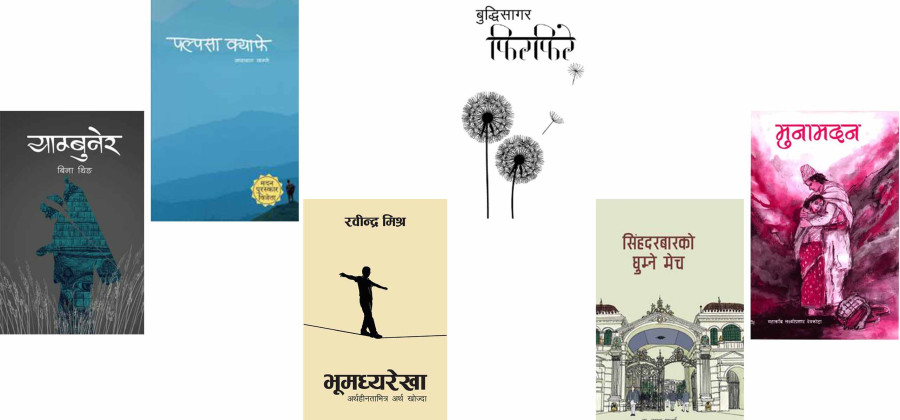Culture & Lifestyle
What makes you pick up a book?
A book is not just its content, it is its feel, say book designers. But what exactly goes behind creating a reading experience?
Srizu Bajracharya
When Sachin Yogol Shrestha talks about book design, his voice over the phone receiver bubbles with joy. There’s just so much people have not understood about the design of books, he says. How much thought goes into making a reader pick up a book and to flip from one page to another, he adds.
“You wouldn’t pick up a book if it doesn’t tell you, ‘I could be interesting’,” he says.
From designing an attractive cover to not making any word or sentence orphan to making sure there aren’t odd spaces between periods that stop you from reading seamlessly, the designer’s work makes reading simple. This construct, however, remains quiet much of the time but it’s as important as the syntax of a language to give readers a smooth reading experience. And to the designer this is everything.
A year ago, Shrestha had also enrolled himself in a month-long Paubha course just to be able to design the cover of Sanjeev Uprety’s ‘Hansa’, a novel that tells the story of a man and a duck that expresses communal life, anthropomorphism and human sentimentality. “As designers, it is necessary that we understand the story first to design the book because when you understand the content of a book you have more room to explore,” says Shrestha.
But usually, when any content is decided to be a book, there are multiple layers of meeting with designers and authors, says Kiran Krishna Shrestha of Nepalaya. “Various expertise goes into making a book attractive,” says Shrestha. “But it is, in the end, the designers’ job to create a work that compliments the content,” he says.
Designers collaborate with authors, editors and publishers, even photographers, to create a visual that allures readers to pick up the book. “A book’s cover needs to appeal to readers and exude a gist of the story, even if you say don’t judge a book by its cover, that’s what we normally do,” says Yogol, who believes the designer also shoulders the marketing of the book.
For a designer, a book’s design is about creating interest and ensuring readability with a good layout that does not hinder the reading experience. It’s about planning pages, font styles, margins and line spacing. But it’s also as much about understanding the printing methods, says Subarna Humagain.
“In the beginning when I started designing I used to be more ingrained in the processes on the screen, but I later realised its the output that matters—if it does not come out right in the paper your design doesn’t really matter,” says Humagain, a graphic designer who has designed hundreds of books.
Humagain once went to great lengths to print Rabindra Mishra’s book ‘Bhumadhya Rekha’, which in its cover had Mishra’s silhouette walking on a string. “We had to reprint the book one day before the inauguration of the book, as the text’s scaling jumbled up during the binding process. That’s also one of the things that we are yet to master properly in Nepal,” says Humagain.
Today, most books available in the Nepali market are printed in India. “And that’s because there is still a dearth of good printing technology and skilled workmanship,” says Humagain.
“Besides the lack of technology, there is also a general lack of seriousness in what we do,” says Humagain. “I have seen printing presses where staff eat food next to papers and books, where they are not bothered by the alignment of binding or extra spaces,” he says. There are other challenges too.
Readability of the Devanagari letters has also been one of the main challenges for the book industry. Many Nepali fonts in terms of readability in print are still not easy to read. Most Nepali books use the ‘shreenath’ font, which is unobtrusive to reading. However, the typeface has a defect, says Humagain. “It’s difficult to manage a chandrabindu (a half moon with a dot) with the font, it only has a default shirbindu (a dot), and the font has not evolved properly,” he says.
Yogol too agrees with Humagain and believes that the Nepali book industry is yet to understand the value of fonts and typography. “Many Nepali fonts have problems with the Nepali vowels and raswo and dirgha,” says Yogol who has designed over 80 books in about two and a half years and is one of the most sought book designers in the market.
“Publication houses are still not ready to invest in their own fonts, and there are some designers who have been creating Nepali fonts on their own, like Anand Maharjan from Calijatra, but a separate market for fonts has not been established properly,” he adds.
A good design helps readers focus; it enhances the work of an author. But that awareness of why purposeful design is imperative is still indiscernible to the general public, says Bhupendra Khadka, the CEO of Book Hill. “We are yet to make our readers receptive of the aesthetic value of a book design; we rarely discuss the story behind the book covers and what goes into making and creating books,” says Khadka.
But one of the foremost publication houses that redefined what a cover of a book should look like was Nepalaya. “It pushed forward the creativity of the book industry in a way,” says Humagain. Nepalaya was coming out with engaging book covers that didn’t stick to the norms of the classic book covers with just an image or art; it focused on the packaging of the books and on the reader’s experience.
“Moving away from the cliched ideas of book designing we focused on designing books in a way that people would like to hold on to them. We wanted to give our readers the feeling of possessing something,” says Shrestha, the team leader of Nepalaya. “To us, a book’s cover was not just a glossy appearance but more than that. We primarily worked on exploring uncommon creative ideas,” says Shrestha.
But creativity is still limited in the larger industry of books, and to put it distinctly, Yogol divides the field of Nepali graphic design into two parts: one that that is ruled and functioning by fast designers, or the ‘Bagbazar designers’, and designers who are ready to immerse themselves in the work they design, who are ready to push creative boundaries.
“Don’t get me wrong, the Bagbazar designers have given so much to the printing industry; however, they have not been able to move forward with time, in the sense, they are not ready to explore. They usually stick to the conformed ways,” says Yogol. “But as designers, I think we should exercise risks, and explore our creativity. We need to come out of our comfort zones,” he says.
Yogol and Humagain, however, are well aware of the grey trades of graphic designing, where designers’ manipulate or trace stock images or use typography found on the internet. “Many designers lack research and the sad part is that we haven’t been able to experiment much; even in terms of editorial text design. But I also believe things are already changing,” says Yogol.
“New designers are pushing the convention of design thinking,” he says.
And much has changed in the book industry in the last decade: from using the literal image of the title to now using explorative metaphors, imageries, graphic art to a more readable text layout, book designing has evolved. “I think the more we explore and discuss these things, the more we will be able to unbind our creativity and give quality work,” says Khadka.
Yogol, who takes book designing as an art, is already planning for a book cover exhibition. “Once I hit 100, I want to exhibit my book covers because I have learned so much in this journey,” he says.
With this growing understanding of the art of designing books, the scope of Nepal’s book designing industry could be opening up to new horizons. “Times are changing, and I think we are seeing more creative book designs and covers. Who knows in the future someone might start book cover competitions; it would be interesting to have something like that to unbound the creativity of designers,” says Shrestha.




 7.98°C Kathmandu
7.98°C Kathmandu















